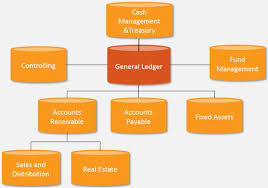Accounts Payable and General Ledger: Lump sum transactions are integral to business operations, though they don’t occur frequently. Sometimes, payments are delayed, necessitating accurate recording to prevent future ambiguities. Such entries are crucial in accounting and are incorporated into the General Ledger. When a payment is postponed for future settlement, it is logged as “Accounts Payable” to maintain transparency and accountability.

Table of Contents
Accounts Payable vs General Ledger
The difference between Accounts Payable and General Ledger is that Accounts Payable is the Sub-heading of General Ledger and in contrast, General Ledger is the Master Heading of Accounts Payable covering every transaction in a business. Accounts Payable does not record entries related to Account Receivable whereas General ledger records both payable as well as Receivable.

The term Accounts Payable refers to the debt owned against vendors, suppliers for the short term as well as long term. In general, it is an extension period provided by the creditor of the firm for payment of a certain amount in the upcoming time. The payment period in Accounts Payable is normally 30, 60, or 90 days cycle.
The term General Ledger refers to an accounting tool used for verification of sub-ledger, accounts, audits, and reporting. All the financial data is maintained in the General ledger of the company in which every debit-credit transaction is specified aptly. It is adopted by the business running on a double-entry system of accounting.

Comparison Table Between Accounts Payable and General Ledger
| Parameters of Comparison | Accounts Payable | General Ledger |
| Indicates | Every outgoing transaction regarding payments of funds is recorded in Accounts Payable. | The general ledger indicates outflow as well as inflows of cash and all other transaction. |
| Types | Accounts Payable is a Subsidiary Ledger. | General Ledger is a Head Ledger consisting of Accounts payable. |
| Purpose | The purpose of the Accounts Payable Ledger is to record the payment outflows of the company or firm. | The purpose of General Ledger is to record every transaction of the company. |
| System | The Accounts Payable is a part of both Double as well as Single-entry systems. | General Ledger is a part of the Double-entry system only. |
| Working | The aggregate amount of Accounts payable is carried over to the General ledger. | General Ledger collects the aggregate amount from each sub-heading for final output. |
What is Accounts Payable?
In the intricate dance of business, there’s a common rhythm pulsing through every organization—a cadence known as Accounts Payable. Picture this: in the bustling corridors of major corporations, the flow of commerce isn’t always about immediate cash exchanges. Instead, it’s a symphony orchestrated by a payment cycle, where dues are settled according to a strategic beat.
Accounts Payable, affectionately known as AP, is the ledger’s way of capturing the owed melody. Here, in the grand theater of the General Ledger, amounts owed to suppliers, vendors, and sundry third parties compose the score. These are the debts waiting to be harmonized, promising payment against the backdrop of goods, raw materials, and essential services.
Imagine a grand ball where suppliers elegantly deliver their invoices, swathed in anticipation, while receivers deftly inscribe them into the company’s ledger. It’s a dance of credit, where businesses gracefully extend their hand in promise, knowing full well they’ll pay their dues in due course. These obligations, often regarded as short-term debts, adorn the company’s financial attire, awaiting their moment in the limelight.
Yet, like threads in a tapestry, these transactions weave their way into the grand design of the General Ledger. Here, amidst the ledger’s hallowed halls, the sum total of all accounts payable finds its rightful place, awaiting its grand debut on the balance sheet’s stage. With the finesse of a maestro, these entries are orchestrated through sophisticated software like SAP or Tally, ensuring every note is played with precision.
For those navigating the labyrinth of financial statements, Accounts Payable takes center stage under the banner of current liabilities. It’s a signpost on the journey, reminding stakeholders of the financial obligations waiting in the wings, ready to step into the spotlight when the curtain rises.
To illustrate, let’s envision a company embarking on a sartorial adventure. Picture a purchase of fabrics destined to be tailored into coats, with a bill totaling $50. As the materials are received and the invoice extended with a grace period of 60 days, the company steps onto the dance floor of Accounts Payable. Here, in the ledger’s embrace, the $50 payment gracefully pirouettes into its rightful place, a debt acknowledged, a promise to be fulfilled.
In the intricate tapestry of business, Accounts Payable is more than just a ledger entry—it’s a testament to the delicate balance of commerce, where promises are made, debts are acknowledged, and the symphony of financial transactions plays on. It’s a melody that echoes through the corridors of every organization, a rhythm that guides the dance of commerce, ensuring every step is taken with grace and precision.
What Is General Ledger?
The General Ledger, a cornerstone of financial accounting, serves as the meticulous record-keeper of all transactions occurring within a business, meticulously categorizing them into various sub-categories. With the finesse of a conductor orchestrating a symphony, the General Ledger deftly assigns entries from disparate ledgers into the realms of liabilities, assets, or equities, aligning them with the precise nature of each transaction. This organizational wizardry unfolds within the digital confines of accounting software, tailored to the unique needs and complexities of each company’s financial landscape.
Operating on the principle of duality, the General Ledger navigates the intricate dance of debits and credits, ensuring that every transaction leaves its mark in both realms. These paired effects, akin to the notes on a musical score, are meticulously cataloged within the ledger’s annals, each entry serving as a veritable journal chronicling the origin and consequences of financial transactions.
But let’s demystify this ledger jargon: imagine the General Ledger as the grand repository, the sum total of all individual ledgers’ contributions. Within its expansive domain, myriad headings emerge—creditors, debtors, current accounts, payables, receivables—each representing a facet of the company’s financial tapestry. Like threads weaving through a complex tapestry, these entries coalesce to form a cohesive narrative, shedding light on the ebb and flow of financial activity within the company.
Now, let’s embark on a hypothetical journey into the realm of the General Ledger. Picture a bustling company, its coffers enriched by the sale of goods to a discerning buyer, who parts with a sum of $100 in exchange. As this transaction unfolds, the company’s assets swell by $100, a testament to its burgeoning wealth, while the account receivable ebbs by an equal measure, marking the buyer’s fulfillment of their obligation. With this elegant maneuver, the General Ledger fulfills its duty, immortalizing the transaction within the annals of accounting history.
Yet, the ledger’s role extends beyond mere record-keeping; it serves as the lodestar guiding the company towards financial clarity and transparency. As transactions unfurl and entries accrue, the General Ledger becomes the crucible from which the trial balance emerges—a pivotal artifact in the quest for financial truth. With the trial balance in hand, financial stewards embark on the final leg of their journey, crafting the Balance Sheet—a tableau of assets, liabilities, and equities—bestowed with the power to unveil the company’s fiscal health with unwavering clarity.
In essence, the General Ledger is the custodian of financial truth, the arbiter of fiscal destiny, and the silent sentinel standing guard over the company’s monetary realm. Through its meticulous record-keeping, adherence to accounting principles and unwavering dedication to accuracy, it lays the foundation upon which sound financial decisions are made and the company’s prosperity is safeguarded. In the ever-evolving saga of commerce, the General Ledger stands as a steadfast ally, navigating the turbulent seas of finance with unwavering resolve and timeless grace.
Similarities Between Accounts Payable and General Ledger
Accounts Payable and General Ledger are both fundamental components of accounting systems, serving distinct yet interconnected functions within an organization. Despite their differences in purpose and scope, several key similarities between Accounts Payable and General Ledger underscore their essential roles in financial management and reporting.
- Recording Financial Transactions: Both Accounts Payable and General Ledger are responsible for recording financial transactions within an organization. AP focuses specifically on transactions related to the payment of obligations to suppliers, vendors, and creditors. These transactions include invoices received for goods and services purchased on credit, as well as any payments made to settle these liabilities. On the other hand, the General Ledger serves as the central repository for all financial transactions across the organization, encompassing not only accounts payable but also accounts receivable, cash transactions, payroll, and other revenue and expense activities. Both AP and the GL play vital roles in ensuring the accuracy and completeness of financial records by recording transactions promptly and accurately.
- Double-Entry Accounting: Another similarity between Accounts Payable and General Ledger lies in their adherence to the principles of double-entry accounting. Double-entry accounting requires that every financial transaction be recorded with equal and offsetting debits and credits to maintain the balance of the accounting equation (Assets = Liabilities + Equity). In the case of AP, when an invoice is received, a debit is made to Accounts Payable to recognize the liability owed to the supplier, while a credit is made to the appropriate expense or asset account to reflect the purchase. Similarly, in the General Ledger, every transaction is recorded with corresponding debits and credits to ensure that total debits equal total credits, thereby maintaining the integrity of the financial records.
- Accrual Basis Accounting: Both Accounts Payable and General Ledger operate under the accrual basis of accounting, wherein revenues and expenses are recognized when they are earned or incurred, regardless of when cash is exchanged. This means that transactions are recorded as soon as they occur, even if payment has not yet been made or received. In the case of AP, when goods or services are received on credit, the corresponding liability is recognized in the Accounts Payable account, irrespective of when the actual payment will be made. Similarly, the General Ledger records revenue and expense transactions as they occur, allowing for more accurate financial reporting by reflecting the economic substance of transactions rather than just the timing of cash flows.
- Financial Reporting: Both Accounts Payable and the General Ledger contribute to the preparation of financial statements and reports that provide stakeholders with insights into the financial health and performance of the organization. Accounts Payable plays a crucial role in the preparation of the balance sheet by reporting the amount of outstanding liabilities owed to creditors and suppliers as of the reporting date. Additionally, AP balances are often used in liquidity and working capital analyses to assess the organization’s ability to meet its short-term obligations. Similarly, the General Ledger forms the basis for generating the trial balance, which summarizes the balances of all accounts at a specific point in time, and serves as the foundation for preparing financial statements such as the income statement, statement of retained earnings, and cash flow statement. By providing accurate and comprehensive financial data, both AP and the GL enable stakeholders to make informed decisions and evaluate the financial performance and position of the organization.
- Internal Controls: Effective internal controls are essential to safeguarding assets, ensuring compliance with regulations, and maintaining the integrity of financial information. Both Accounts Payable and the General Ledger are subject to internal control measures designed to mitigate risks and prevent errors or fraud. In Accounts Payable, internal controls may include segregation of duties, approval processes for invoices and payments, regular reconciliations, and periodic audits to detect discrepancies or irregularities. Similarly, the General Ledger is subject to controls such as review and approval of journal entries, segregation of duties between recording and authorization, and reconciliation of accounts to subsidiary ledgers and supporting documentation. By implementing robust internal controls, organizations can minimize the risk of misstatements or fraudulent activities and enhance the reliability of their financial reporting processes.
- Integration with Other Systems: Accounts Payable and the General Ledger are often integrated with other systems and modules within an organization’s accounting software or enterprise resource planning (ERP) system. This integration allows for seamless flow of information between different functional areas, such as procurement, inventory management, and financial reporting. For example, Accounts Payable modules may be linked to purchase order systems to ensure that invoices are matched with corresponding purchase orders and receipts before payment is authorized. Likewise, the General Ledger module may interface with accounts receivable, payroll, and fixed asset systems to capture relevant financial data and transactions for reporting purposes. By integrating AP and the GL with other systems, organizations can streamline processes, improve data accuracy, and enhance decision-making capabilities.
- Audit Trail and Documentation: Both Accounts Payable and General Ledger maintain detailed records and documentation of financial transactions, providing an audit trail that supports transparency, accountability, and compliance with regulatory requirements. In Accounts Payable, this documentation includes invoices, purchase orders, receiving reports, payment authorizations, and vendor contracts, which serve as evidence of the obligations incurred and payments made by the organization. Similarly, the General Ledger maintains a comprehensive record of journal entries, adjustments, and reconciliations, along with supporting documentation such as bank statements, invoices, and payroll records. This documentation not only facilitates internal review and analysis but also enables external auditors to verify the accuracy and completeness of financial statements and assess the effectiveness of internal controls.
In summary, Accounts Payable and General Ledger are integral components of accounting systems that share several similarities in terms of recording financial transactions, adhering to double-entry accounting principles, operating under the accrual basis of accounting, contributing to financial reporting, implementing internal controls, integrating with other systems, and maintaining audit trails and documentation. By understanding these similarities and leveraging the complementary functions of AP and the GL, organizations can effectively manage their financial operations, ensure compliance with regulatory requirements, and provide stakeholders with reliable and transparent financial information.
Main Differences Between Accounts Payable and General Ledger
- Treatment: In Accounts Payables, only a single type of entry is treated whereas, in General Ledger, multiple types of entries are treated.
- Reference: The entries of Accounts Payable are only referred to the creditors whereas entries in General Ledger are concerned with creditors as well as debtors of the company.
- Information: The information accompanied in Accounts Payable is limited whereas the information accompanied in General Ledger is comprehensive.
- Output: The output of Accounts Payable becomes the part of General Ledger and the output of General Ledger becomes the part of Trial Balance.
- Balance Sheet: One cannot prepare the Balance Sheet with the help of Accounts Payable on the contrary Balance sheet can be prepared with the help of a General Ledger.
Conclusion
Apart from the aforementioned differences, both General Ledgers and Accounts Payables play a vital role in finalizing the accounts of the company. Since investors don’t give preference to these two accounts as investors are concerned with Balance Sheets only these two terms create a foundation for Financial Statements.
Permanent records of day-to-day transactions are stored in the General Ledger and there can be more than one heading for Accounts Payable under the master heading of the General Ledger. Both terminologies serve different meanings to Books of accounts of the company. These Accounts Payables are reconciled on a recurring basis to have the actual position of the short-term debt of the company.

